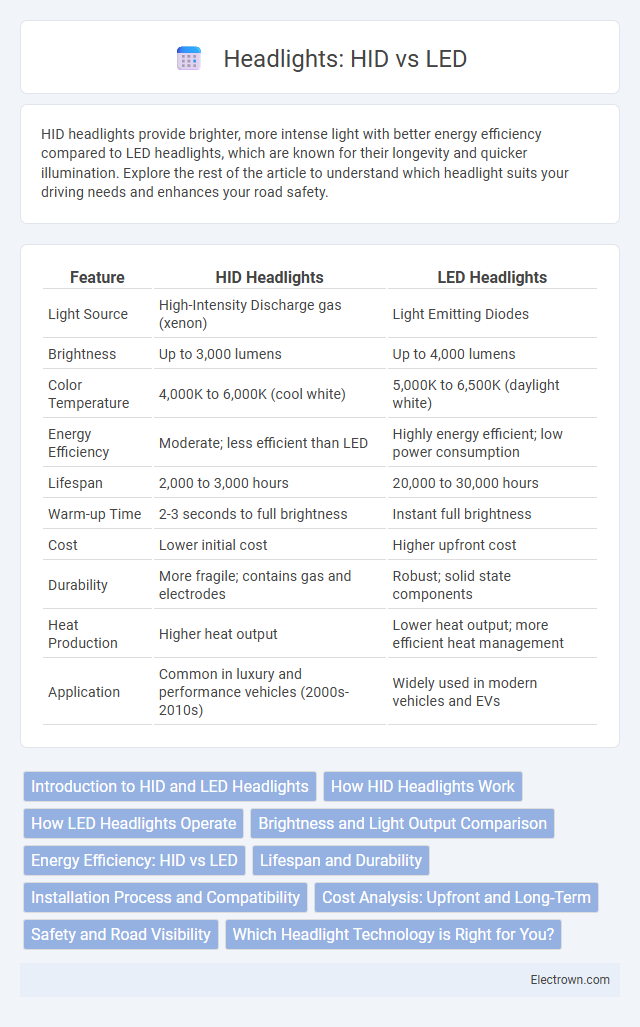HID headlights provide brighter, more intense light with better energy efficiency compared to LED headlights, which are known for their longevity and quicker illumination. Explore the rest of the article to understand which headlight suits your driving needs and enhances your road safety.
Table of Comparison
| Feature | HID Headlights | LED Headlights |
|---|---|---|
| Light Source | High-Intensity Discharge gas (xenon) | Light Emitting Diodes |
| Brightness | Up to 3,000 lumens | Up to 4,000 lumens |
| Color Temperature | 4,000K to 6,000K (cool white) | 5,000K to 6,500K (daylight white) |
| Energy Efficiency | Moderate; less efficient than LED | Highly energy efficient; low power consumption |
| Lifespan | 2,000 to 3,000 hours | 20,000 to 30,000 hours |
| Warm-up Time | 2-3 seconds to full brightness | Instant full brightness |
| Cost | Lower initial cost | Higher upfront cost |
| Durability | More fragile; contains gas and electrodes | Robust; solid state components |
| Heat Production | Higher heat output | Lower heat output; more efficient heat management |
| Application | Common in luxury and performance vehicles (2000s-2010s) | Widely used in modern vehicles and EVs |
Introduction to HID and LED Headlights
HID (High-Intensity Discharge) headlights produce light by creating an electric arc between two electrodes inside a xenon-filled bulb, offering brighter and more intense illumination compared to traditional halogen lights. LED (Light Emitting Diode) headlights use semiconductor technology to emit light efficiently with lower energy consumption and longer lifespan. Choosing between HID and LED headlights impacts your vehicle's lighting performance, energy efficiency, and maintenance requirements.
How HID Headlights Work
HID (High-Intensity Discharge) headlights generate light by creating an electric arc between two electrodes inside a xenon gas-filled bulb, producing a bright, intense white or bluish light. This arc excites the xenon gas, resulting in higher luminance compared to traditional halogen bulbs, improving nighttime visibility and energy efficiency. HID systems require a ballast to regulate voltage and maintain a consistent electrical arc for optimal performance.
How LED Headlights Operate
LED headlights operate using light-emitting diodes that produce illumination through electroluminescence, where electrical current passes through a semiconductor material, generating light with high energy efficiency. These headlights convert most energy directly into visible light rather than heat, resulting in lower power consumption and less heat generation compared to HID counterparts. LED systems also offer faster response times and better directional control, enhancing driving visibility and safety.
Brightness and Light Output Comparison
HID headlights produce a higher brightness level, typically ranging between 3,000 to 3,500 lumens, compared to LED headlights, which offer around 2,000 to 3,000 lumens. The light output of HID bulbs is more intense and covers a broader area, enhancing visibility during night driving and adverse weather conditions. LED headlights, while slightly lower in brightness, provide a more focused beam, longer lifespan, and quicker illumination response time.
Energy Efficiency: HID vs LED
LED headlights consume significantly less energy than HID headlights, converting a higher percentage of electrical power into visible light. HID bulbs typically have an energy efficiency of around 70-90 lumens per watt, whereas LED technology often exceeds 100 lumens per watt, resulting in lower power consumption and reduced battery strain. This increased energy efficiency of LEDs contributes to longer vehicle battery life and improved fuel economy in combustion engine cars.
Lifespan and Durability
LED headlights typically offer a lifespan of up to 30,000 to 50,000 hours, far exceeding HID headlights, which last around 2,000 to 3,000 hours. LEDs are more durable because they resist shock and vibration better, making them ideal for rough driving conditions. Your vehicle benefits from reduced maintenance and fewer replacements with LED headlights, ensuring long-lasting performance.
Installation Process and Compatibility
LED headlights offer a straightforward installation process compatible with most modern vehicles, often requiring only a plug-and-play setup without modification. HID headlights usually need additional components like ballasts and wiring harnesses, making installation more complex and potentially incompatible with some car models. Ensure your vehicle supports the necessary electrical setup to avoid compatibility issues when upgrading your headlights.
Cost Analysis: Upfront and Long-Term
LED headlights generally have a higher upfront cost compared to HID headlights, but they offer lower energy consumption and longer lifespan, reducing long-term replacement and maintenance expenses. HID headlights are less expensive initially but consume more power and require bulb replacements more frequently, increasing overall ownership costs over time. Evaluating total cost of ownership, including electricity usage and replacement frequency, often makes LEDs a more economical choice despite the steeper initial investment.
Safety and Road Visibility
HID headlights provide brighter, more intense light with a color temperature closer to daylight, enhancing road visibility and allowing you to detect obstacles and hazards earlier. LED headlights offer fast illumination and a more focused beam pattern, improving safety by reducing glare for oncoming drivers and providing consistent performance in various weather conditions. Both technologies significantly improve nighttime driving safety compared to traditional halogen bulbs, but LED headlights tend to have longer lifespan and better energy efficiency.
Which Headlight Technology is Right for You?
HID headlights produce a brighter, whiter light with better long-range visibility, ideal for night driving in rural or poorly lit areas. LED headlights offer energy efficiency, longer lifespan, and quicker activation, making them suitable for city driving and frequent use. Your choice depends on whether you prioritize enhanced brightness and distance or durability and energy savings.
HID vs LED headlights Infographic

 electrown.com
electrown.com